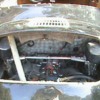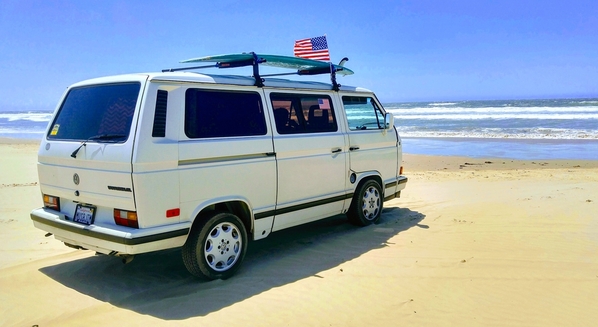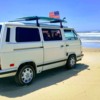What are the advantages of a type IV engine in our cars? Thank you.
Replies sorted oldest to newest
Use the search (spy glass) feature on site - lots of posts on it.
- 30 year more modern design - with strong weldable aluminum case (most all)
- Modern full flow oil filter
- Strong lower end
- Base 80 hp vs 50 hp
- Easy 103 mm piston cylinder size 2400-2600 cc reliable engines common
The type 4 engine was the last in the design of the aircooled 4-cylinder from VW and, as such, it has fixed all of the problems we have all corrected the hard way on our type 1 engines and then some. Without much work you can get 140 - 150hp out of them almost stock and getting more than 200hp from a modified engine is pretty easy.
They started at 1.8 liter and can easily be expanded from there to close to 3 liters. They have a real, spin-on oil filter mount cast into the engine case, as well as beefier crankshaft main bearing mounts - In fact, everything about the basic engine is stronger/better than the type 1. With the original pancake cooling system they were somewhat more efficient at cooling the engine, although I have only seen a pancake engine in one Speedster - usually they've been converted back to the upright version.
So, advantages: 1. It is the most mature design of the VW aircooled engine.
2. It starts around 140hp as we dress them - the same as a 2,110 type 1.
3. They were made slightly easier to service.
4. Everything I've heard is that they're reliable as anything.
There is undoubtedly more but that's all I've got.
Disadvantages:
1. Since they made far fewer of them (only for the VW type 4 and the Porsche 912 and 914 for a few years), they're a bit harder to find (but those found seldom have a distorted case around the crankshaft from mis-use as do many Type 1 engines for sale for rebuild).
2. Parts tend to be more expensive and sometimes harder to find than those for a type 1.
3. There are fewer competent people around to build or work on them.
That's all I've got - I'm sure others can fill in more.
History: VW 411/412 came first with T4 (1968-1974). Most were automatic in US. The VW bus (T2) first used T4 engine starting in 1972- around 1976. Bus was dual Solex with lower compression/hp initially. Pushing that non-aerodynamic heavy bus took its toll on that engine. The 914 was produced 1970-1975. They were rust prone on NE Coast - so decent supply available. First 2 years were 1.7L with fuel injection and higher compression (and hp). In 1973 engine size increase to 1.8L but lower hp so a 2.0 L was also introduced (71 mm stoke vs 66 mm). 2L produced 106 hp. The 912E was a one year Porsche in 1976 that used the T4 in a 911 body (rare car car with 2092 produced). US used FI not for performance but for emissions (carbs were used in Europe). The flat pancake version will fit - its about 5-6" deeper with cooling (saving $1k for up right cooling).
Attachments
Great information I think I might stay with a type 1 for now. Thank you.
They can be a lot bigger, and they run a lot cooler.
They cost a lot more to build right.
For a while, I was interested in the so-called Type V. It is a water-cooled flat-four with water jacket removed. So the case internals are more robust than the Type 1 but it can use Type 1 cylinders and heads. Also, it is easier to convert to upright than the Type IV.
There is a forum about it on Shoptalkforums.com.
Interesting. Thank you for the site.
@Michael McKelvey posted:For a while, I was interested in the so-called Type V. It is a water-cooled flat-four with water jacket removed. So the case internals are more robust than the Type 1 but it can use Type 1 cylinders and heads. Also, it is easier to convert to upright than the Type IV.
There is a forum about it on Shoptalkforums.com.
Guys take a wasserboxer Vanagon motor and yes, cut off the cylinder water jackets.
The cranks are 76mm, and stock cylinders are 94mm, making a 2109. I don't know if bigger than 94mm cylinders could be fitted or if stroker cranks are even available. Having had 1991 Vanagon Westy, I do know a little about them. I believe the whole affair is a combo of type1 and type4 stuff with watercooled cylinders and heads thrown in, with Digifant injection also. I do know that they had a 5 bolt flange for the flywheel, so that right there makes them more reliable than a type1.
Same pushrod tubes and pushrods as a type1. Hydraulic lifters, so don't know if you'd want that or not.
I do know they made all of 90hp, on a good day, with 2.1 liters of displacement. Kind of sad really, when the Suby EJ22 at 2.2 liters makes 130hp ALL DAY LONG. And don't even get me started on the EJ25 at 165hp MINIMUM.
Anyway, I know guys have had good luck modifying the Wasserboxer cases to aircooled. It makes more sense to me to just buy a brand new aluminum case with all the trimmings, IF you're going type1.
The negative with hydraulic lifters is when one decides to get dirt in it , the lifter will bang like crazy and the fix is to split the case to get to it. Happened to me on a type 1 ....once.
I owned a 69 beetle and the controls were always passenger side ON & increasing heat and the drivers side for defrost or footwells... but I had no idea about the turning heat button that a friend had in his 67. Dagmar, who worked at a local grocery store, was her german accent thick, I loved it, well she had a Notchback, now that was a cool car.
There aren't a lot of after market parts for T4 since there weren't nearly as many built as the T1 engine. You can simply rebuild the T4 with stock parts and end up with a reliable 100-120 hp engine. The FI cam should be replaced when going to carbs. Plus the exhaust needs to fabricated (there are off shelf ones like Tangerine but they are $$$).
Tiger at A1 makes a sidewinder for T4.
Lenny's 2270 in his Spyder easily makes 150hp and has tons of torque. He had Tangerine make his exhaust for him. He's running a DTM with the stock type oil cooler and the funky hose feeding air to it.
@DannyP posted:Lenny's 2270 in his Spyder easily makes 150hp and has tons of torque. He had Tangerine make his exhaust for him. He's running a DTM with the stock type oil cooler and the funky hose feeding air to it.
I would imagine that car to be a missile. That sounds really, really tasty.
It is, at 1500 pounds.
@Stan Galat posted:Tiger at A1 makes a sidewinder for T4. - @Stan Galat
I wasn't aware of that! I learn something new every time I visit this forum. I will go by Tiger's shop and research this for my '89 Vanagon. ![]()
Attachments
Jim, you don't have a type 4, you have a 2.1 liter Wasserboxer. The exhaust ports are basically the same as a Beetle. But, you have a catalytic converter and if you remove it, the sky will fall in the Communist State of Kalifornia! LOL!
@DannyP posted:Guys take a wasserboxer Vanagon motor and yes, cut off the cylinder water jackets.
The cranks are 76mm, and stock cylinders are 94mm, making a 2109. I don't know if bigger than 94mm cylinders could be fitted or if stroker cranks are even available. Having had 1991 Vanagon Westy, I do know a little about them. I believe the whole affair is a combo of type1 and type4 stuff with watercooled cylinders and heads thrown in, with Digifant injection also. I do know that they had a 5 bolt flange for the flywheel, so that right there makes them more reliable than a type1.
Same pushrod tubes and pushrods as a type1. Hydraulic lifters, so don't know if you'd want that or not.
I do know they made all of 90hp, on a good day, with 2.1 liters of displacement. Kind of sad really, when the Suby EJ22 at 2.2 liters makes 130hp ALL DAY LONG. And don't even get me started on the EJ25 at 165hp MINIMUM.
Anyway, I know guys have had good luck modifying the Wasserboxer cases to aircooled. It makes more sense to me to just buy a brand new aluminum case with all the trimmings, IF you're going type1.
Yup the Subaru EJ25 naturally aspirated can be built reliable up to 200 hp flying past 7000 rpm with the flick of the throttle. Ask me how I know. Or ask Danny or Stan.
I think when I get too decrepit for the Spyder I’ve got one more 356 in me. I’ve got a brand new pair of dells still in original boxes and I sure would like to put them on a type 4. But the suby is tough to beat particularly for the dollar/hp.
Have you started your dream sheet Phil, now that your kids are off the gravy train you should be freer ![]()
Ray I’m pretty good right now with the Spyder and the BMW Roadster. One day I’ll be trading the Spyder for a 356. Sometimes I really do miss my IM. If it wasn’t so slow I’d still have it. Love the role up windows and ability to go anywhere in any weather. My thoughts about a possible 356 in my future include an IM speedster, a Vintage coupe or possible a Beck convertible D. Don’t know if Carey is listening but I’d sure like to know if his new platform will be offered with the convertible D with role up windows. Mine would have to be rear engine. I’ve got at least 5 more years to think about it.
Well you know how a N/A subie feels like now, but adding more weight you might like to add a turbo. Actually, I was at my subie race tech and they keep suggesting I drop in something similar to Marty's IM 240hp turbo and they can mod the ECU to make it very linear in acceleration like a NA.
As for your time line, IM might be no longer making ICE engines by then, I hope they continue on, for the Canadian market at least, but Carey certainly is moving forward with the coupe and with all that experience and Lane being the guinea pig we have a chance of maybe getting more from Bremman... I mean, with all that work, it must be soon out of the neonatal stage as he has finished with Anand. ![]()
"...you have a catalytic converter and if you remove it, the sky will fall in the Communist State of Kalifornia! LOL!" - @DannyP
Funny, but TRUE! ![]()
Gently, fellas: a cat doesn't hurt anything and helps the planet and its resident mammals breathe.
Says the guy with a catless Subaru conversion.......
Bridget has a cat.
Oh. Sorry about that, Mr. Carbon-zero LOL!
@edsnova posted:Gently, fellas: a cat doesn't hurt anything and helps the planet and its resident mammals breathe.
I'll buy the blue statement. However the yellow one is not true. There is always a flow restriction through a cat small enough heat up adequately, and therefore a cost in engine output and heat management. Modern engines have been designed to work around that heat and flow restriction, but most modern hi-po engines have pretty big cats, which flow as well as possible.
Jim's wasserboxer is water-cooled, and can probably deal with the heat (although the engines in those things aren't renowned for their longevity), but sticking one a T1 is a recipe for a very short life.
@Stan Galat I don't think anyone was suggesting putting a cat on a Type 1 engine. But if you leave one on your Subie conversion it's really NBD.




